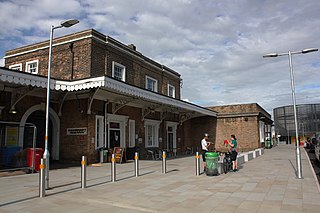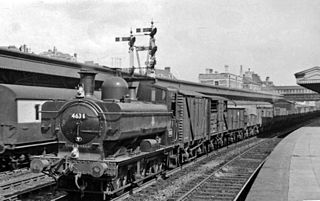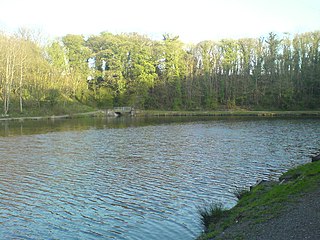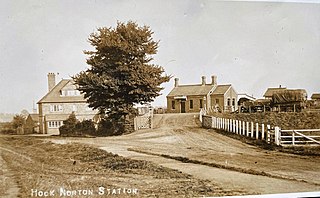This article needs additional citations for verification .(July 2007) |
Croes Newydd was a large steam locomotive shed, marshalling yard and junction in Wrexham, in Wales.
Contents

This article needs additional citations for verification .(July 2007) |
Croes Newydd was a large steam locomotive shed, marshalling yard and junction in Wrexham, in Wales.

The Wrexham and Minera Railway was opened on 22 May 1862, with little ceremony except a note from the Traffic Manager of the Great Western Railway stating that from that date all traffic on that line would be invoiced to or from Croesnewydd station instead of Wheatsheaf. [1] This new station was a goods station "situated at the side of the highway leading from Croesnewydd to the Ruthin Road a short distance from the canal". Six sidings were provided here able to accommodate hundreds of wagons, and dealt with the weighing of goods from several collieries,including the Minera limeworks, Broughton Hall iron works, Brymbo furnaces, and other goods on the line.
Wrexham's Croes Newydd locomotive shed was the last of the GWR 'northlight' designs, being a roundhouse and depending on a central turntable for access. It was built by the Great Western Railway and opened in 1902, to replace outdated facilities at Wheatsheaf junction. It was located in the centre of a large fork junction, with the Chester to Shrewsbury line running along one edge, and the branch being the Wrexham and Minera Branch. The sheds also featured a GWR combined water tower and coaling stage, a design which was later to become standardised.
While the 'northlight' design was meant to allow maximum sunlight, the skylight windows quickly became sooty and black, reducing lighting conditions. The sheds stored several locomotives known as "workhorses" as they did the goods work. The last of these locomotives were the BR Standard 9F locomotives, the last of the British steam locomotives.
Under the cutbacks of BR in the 1960s, the shed finally closed in 1967.However, it was the last shed on the entire BR system to house working standard gauge GWR locomotives, with 56XX tank locomotives on the roster well into 1966.
Up until the late 1970s, sidings on the north curve of the former depot site were used for stabling diesel locos at weekends including Class 25s and Class 40s in association with Brymbo steelworks duties. However, with the closure of the Brymbo branch on 1/10/82 this practice ceased as a regular stabling point. Between closure and the 1980s, Wrexham Corporation (now Wrexham County Borough Council) opened a yard and depot on part of the site. This was home to the town and surrounding area's rock salt store, as well as the grit spreaders that dispersed it in cold weather. Also kept here were all thegrass cutting equipment and road maintenance equipment. After sustaining damage from a minor fire in one of the buildings, the depot was closed and relocated to the nearby Wrexham Industrial Estate in 2009.
In the 1990s, sidings to the southwest of the triangle were developed as a suburban housing estate; Named Llys-David-Lord (David Lord Court), named after David Lord, a famed aviator. Such was the pace of putting up fencing that the siding points continued under the newly erected fence line! Apart from the sidings, the only thing left was an old BR brake van. In the 2000s, the nearby Wrexham Maelor Hospital extended its car park onto the site of the marshalling yard to the west of the triangle.


Now that the shed and marshalling yard were gone, the only remaining features were the Croes Newydd North and South Fork signal boxes. However the closure of the Wrexham and Minera Railway closed the South Fork signal box, leaving the North Fork box as the only remaining box in the Wrexham area.
In 2010, Morrisons, a national supermarket chain, announced its intention to develop a majority of the remaining vacant land into a supermarket and adjoining car park. [2] This will be the first time in almost fifty years that the land has been occupied, and is being subjected to intense environmental rules, as over the years, the untamed scrub land and low lying debris from the original usage have formed natural habitats for a wide array of species. Some of the site will be retained as scrubland for possible future usage, and the route of the Northern fork of the Junction will be used as a path and cycleway to the level crossing near the North Fork Signal Box. This forms part of a route following the route of the Wrexham and Minera Railway as far as Moss Valley.

Yeovil Junction railway station is the busier, but less central, of two railway stations serving the town of Yeovil in England. The station is 2 miles (3.2 km) outside the town, in the village of Stoford. Although Yeovil is in Somerset, the station was in Dorset until 1991. It is 122 miles 48 chains (197.3 km) down the line from London Waterloo.

The Buckley Railway was opened from Buckley to a connection with the Chester to Holyhead main line on 7 June 1862, to convey coal and finished brickworks products from the Buckley area. Numerous short tramroads had existed in the area from the 1700s. The line was steeply graded and sharply curved.

Taunton railway station is a junction station on the route from London to Penzance, 163 miles 12 chains (263 km) west of London Paddington station, measured via Box. It is situated in Taunton, Somerset, and is operated by Great Western Railway. The station is also served by CrossCountry trains and by the West Somerset Railway on special event days and by mainline steam excursions.

The GWR 5700 Class is a class of 0-6-0PT steam locomotive built by the Great Western Railway (GWR) and British Railways (BR) between 1929 and 1950. With 863 built, they were the most prolific class of the GWR, and one of the most numerous classes of British steam locomotive.

Newton Abbot railway station serves the market town of Newton Abbot in Devon, England. It is 214 miles 5 chains (345 km) from London Paddington. The station today is managed by Great Western Railway, who provide train services along with CrossCountry.
The Wrexham and Minera Railway or Wrexham and Minera Branch was a railway line in North Wales between the city of Wrexham, the village of Brymbo where it served the Brymbo Steelworks, and the lead mines and limeworks at Minera. A further branch ran from Brymbo to Coed Talon, where it connected with lines to Mold. The system was constructed in several stages between 1844 and 1872, while the various lines making up the system closed in 1952, 1972 and 1982.
The North Wales Mineral Railway was constructed in Wales in 1844, during the early years of the Railway Mania. It was originally intended to link Chester via Wrexham to the industrial areas around Ruabon; there were branches to Brymbo and Minera from Wheatsheaf junction via a tunnel and inclined plane. The initial plan was to tap the mineral reserves of the area.
Wheatsheaf Junction was the name given to the location where a branch of the North Wales Mineral Railway to Brymbo connected with Shrewsbury and Chester line between Wrexham and Gresford.

Laira Traction and Rolling Stock Maintenance Depot is a railway traction maintenance depot situated in Plymouth, Devon, England. The depot is operated by Great Western Railway (GWR) and is where their fleet of High Speed Trains are overhauled along with those belonging to CrossCountry. These will be withdrawn in 2023 but it will then become the principal depot for GWR's Class 802 InterCity Express Trains. Other trains visit for daily servicing.

The Moss Valley is an area and country park in Wrexham County Borough, Wales. The area, informally known as "The Moss" and The Aggey by local people, has an extensive coal mining history.
The Sheffield District Rail Rationalisation Plan was a series of linked railway civil engineering projects, station and line closures and train route changes that took place in and around Sheffield, South Yorkshire. The majority of these changes took place in the 1960s and early 1970s, however the plan, by now much modified in the face of rapidly dwindling freight traffic, was not fully realised until the 1980s.

Wath marshalling yard, also known as Wath concentration yard, was a large railway marshalling yard specifically designed for the concentration of coal traffic. It was set at the heart of the South Yorkshire Coalfield, at Wath-upon-Dearne, approximately halfway between Barnsley and Doncaster, in the United Kingdom. It opened in 1907 and closed in 1988.

Moorswater railway station was the centre of operations for the Liskeard and Caradon Railway and the Liskeard and Looe Railway. The two railways made an end on junction here. It was the site of the lines' engine shed, also a china clay works which is now used as a cement terminal.

Plymouth Friary railway station was the London and South Western Railway (LSWR) terminus in Plymouth, Devon, England.

Shrewsbury TMD is a railway traction maintenance depot (TMD) situated in Coleham, Shrewsbury, England. The TMD forms part of Coleham Depot, a permanent way depot operated by Network Rail. The code for the TMD is 'SB'.

Hook Norton railway station served the village of Hook Norton in northern Oxfordshire, England.

The North Wales Mineral Railway was formed to carry coal and ironstone from the mineral-bearing area around Wrexham to the River Dee wharves. It was extended to run from Shrewsbury and formed part of a main line trunk route, under the title The Shrewsbury and Chester Railway. It opened in 1846 from Chester to Ruabon, and in 1848 from Ruabon to Shrewsbury. It later merged with the Great Western Railway.
Moss Valley branch was a two mile long single track line built by the Great Western Railway in what is now the county borough of Wrexham, Wales. It ran from a junction with the Wrexham and Minera Railway at Moss Valley Junction to Moss Halt via three intermediate stations: Gatewen Halt, Pentre Broughton Halt, and Gwersyllt Hill Halt.

Kings Cross Top Shed was a large steam locomotive maintenance and stabling depot just north of King's Cross railway station on the far side of Regent's Canal.

The Brymbo railway branch lines served the rich reserves of coal, iron, limestone and other minerals in an area around Brymbo to the west of Wrexham in Wales. Coalowners and others needed transport to get their products to market and lines were built from the main line into the mineral-bearing area. The topography was difficult and gradients were steep. The Great Western Railway became dominant, but a rival company built a competing line and branches.